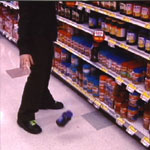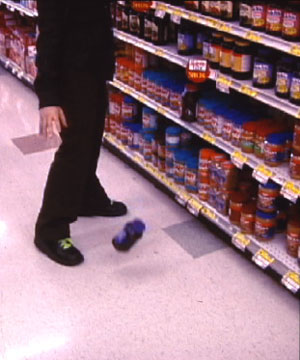In her current video installation at Sala Diaz in San Antonio, Melissa Longenecker’s consumerist performance is both jarring and cathartic. The Great Wide Flourescence takes its title from the expanse of light, space, and stuff that is the landscape of the bargain supercenter (in this case a KMart in Los Angeles, CA).
Over the course of a year, Longenecker documented her forays into the store, where she wandered the aisles and literally wreaked havoc with the merchandise. The edited video footage, projected on two approximately 10 x 10 foot walls opposite each other, documents what happens at the extremities of consumer desire.
On one side of the gallery plays the roughly cut footage in which, shot after shot, we see Longenecker in a different aisle of the store. In some more melancholic moments, she strolls, she looks, she rests, she contemplates. With a lover’s caress, she runs her fingers along the rows of merchandise, considering the tubes of hand lotion and bottles of motor oil with equal affection. We see her squeezing rolls of paper towels and furry stuffed animals with a child’s reverie. In other, more dramatic instances, she loses all restraint and runs completely amok, creating some of the most hilarious, powerful, Baroque, shocking scenes in the piece. She commits such renegade acts as sweeping her arm across a shelf of boxed crackers as they all fall to the floor, pulling down whole displays of luggage, and falling into a bin full of pillows. In some instances we get a more subjective sense of her rebellion and revelry, such as a close-up of her guzzling a Coke right off of the shelf and an occasional smirk at the camera. Wider shots document the extent of both her ecstasy and wrath on entire decimated aisles: once-tidy rows of mouthwash, plastic ware, bath towels, pantyhose, toilet seat covers, etc., are left in utter disarray.
![]()
On the opposite wall is a stop-motion animation compiled of countless hours of footage shot solely of the shelved merchandise. Manipulated to appear as though the objects themselves are moving, everything from laundry detergent to sporting goods come to life — spinning, marching, and shifting around with manic choreography. A masking effect added during post-production creates the illusion that the aisles are floating in a large black void. The effect is disorienting, feeling as though you are moving jerkily along on a carnival ride through miles and miles of supercenter limbo.
![]()
The installation as shown at Sala Diaz is given added meaning by the fact that while the videos are playing, they are being dubbed simultaneously by live workers situated intimately in the space with you. Each videotape being projected is a duplication of the one that played immediately prior, so that what you see when you encounter the work may possibly by now be into the hundred-plus version of the master tape. In the course of such multi-generational dubbing the video images begin to degrade with fuzzy definition loss, or most notably by “rainbowing” — where the colors intensify (get “hot” in video jargon) and bleed into each other.

The process of breaking down the video image through repeated dubbing echoes the process of Longenecker’s performance itself, in which the proper codes of behavior within a specific cultural context (in this case shopping) are also broken down by a persistent cycle of use and abuse. Here, the cycle of commodity and desire create a frenzied downward spiral in which the buyer is so drawn to the products that their interaction ultimately erupts in violence and disorder. It is a ridiculous, but not unimaginable, extreme. This is echoed by the fact that apart from an occasional glimpse of a confused onlooker in the background, the camera is predominantly framed on Longenencker herself, suggesting the eerie notion that perhaps she is alone in the store and free to do as she pleases.
Different from Sylvie Fleury who takes the accoutrements of her own shopping affinity into the gallery and creates sculptural installations out of items such as designer shoes or luxury cosmetics, Longenecker documents her site specific works on video at the moment that they occur in the “non-art” setting. In fact, much of what is rousing about the work comes from realizing that is was done guerilla-style, similar to Gillian Wearing’s 1994 video Dancing in Peckham, in which the artist comically moves to her own rhythm, dancing awkwardly by herself in the middle of a shopping mall. These videos’s power derives from the thrill and acute discomfort of viewing an actual violation of normally acceptable behavior.
Images courtesy the artist and Sala Diaz.
Michael Velliquette is an artist and Co-Founder of The Bower, an artist-run exhibition space in San Antonio, along with Joey Fauerso and Leslee Fraser. He is also the Assistant Director of Finesilver / FYI in San Antonio.



